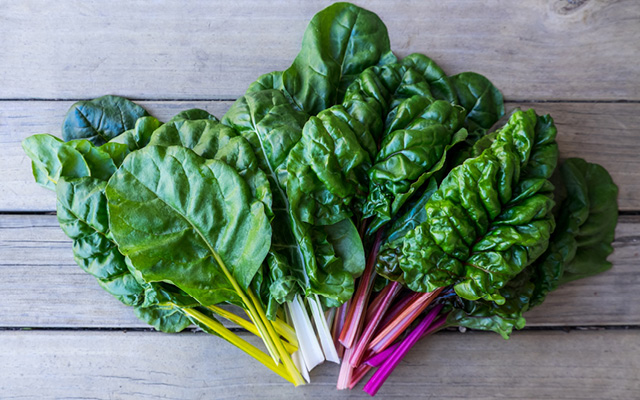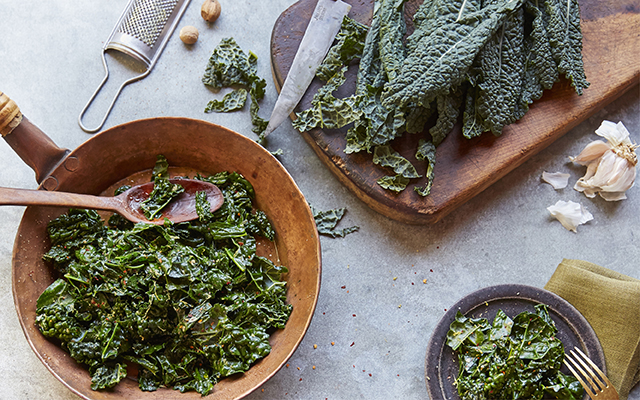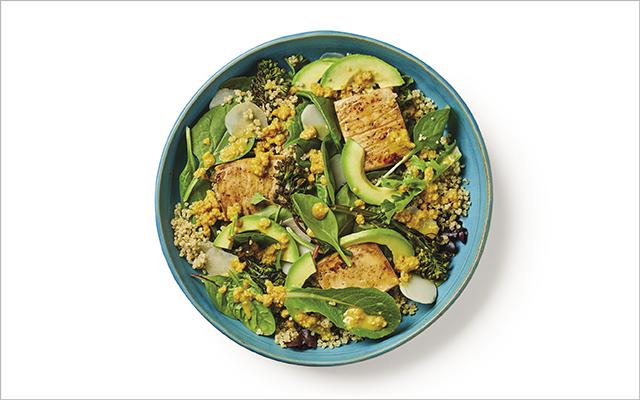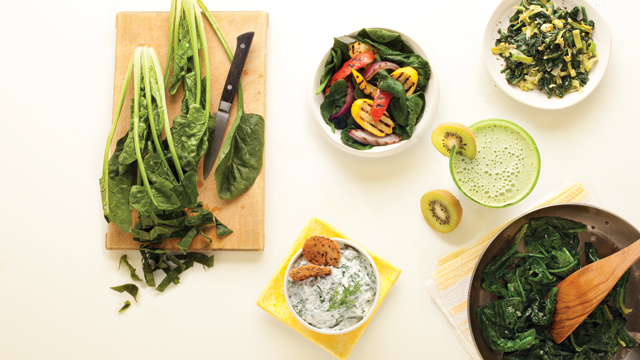Spring, our natural season of renewal, is the ideal time to recapture any ground lost over the winter, especially when it comes to diet and nutritional needs. It’s also an opportunity to build momentum for the glorious farm-stand season of summer. Say “so long” to the hearty roasts and sturdy braises of winter: It’s time to step on the energetic gas pedal, and in spring I do this with rich, dark greens: spinach, collards, kale, chards, mustards, lettuces, dandelions and others that are erupting from local farms.
Not only are they versatile (they take well to all sorts of preparations), dark greens are also jam-packed with wonderful nutritional benefits – a terrific jump-start for anyone needing a gentle nudge out of the winter doldrums.
More Power to You
You’ve no doubt heard about the “five a day” nutritional plan (five servings of vegetables daily). Well, dark greens are a great way of getting those fab five, because there are so many ways to incorporate them into your diet, plus they are such a rich source of vitamins A, C and E, as well as minerals like iron, potassium and magnesium.
Vitamin A helps maintain healthy eyes, skin and gastrointestinal function. Vitamin C is responsible for more than 300 metabolic activities in the body, and vitamin E contributes to normal cardiovascular function. Magnesium aids enzyme production, especially those associated with energy production. Potassium keeps your nervous system working at peak efficiency, and one of iron’s greatest benefits is to help produce hemoglobin and myoglobin, which are the building blocks of a healthy blood system.
Feeling stressed and tired? Eat more dark greens, friend. Not sure where to start? The basic rules for choosing and storing greens are simple and apply to every kind:
Selecting Greens
- First off, fresh is always best; never settle for anything less.
- When it comes to color, greens should be just that – green – so avoid any that show even the slightest signs of yellowing or browning.
- The stems should be slime-free.
- Check carefully for early stages of wilting or pocking.
Caring For Greens
- Just like most other living items, vegetables breathe, and the best way to prolong greens’ freshness (their average life span is three to four days) is to slow down their respiratory function. You can do this by refrigerating them and keeping them moist – dewy, but not wet (water damage speeds spoilage).
- Most greens, even heavy-duty ones like collards, are sensitive and should only be washed and dried just before using. When you get your greens home, roll them in lightly damp paper towels and place the bundle in a zipper bag pricked with a few holes so humidity doesn’t build up and promote spoilage.
Beyond Basic
Many of us are introduced to greens via the salad bowl. Of course, some salads can be real yawners, but dark greens offer plenty of creative ways to jazz them up. Try mixing several types, like spinach, cress, arugula, escarole or dandelion. One of my favorite combinations is cress and arugula dressed with three parts olive oil to one part lemon juice and garnished with shaved Parmesan Reggiano cheese.
I also enjoy making a “blended salad” as a great afternoon pick-me-up and a quick way to get my “five a day.” Think of it as green gazpacho: Toss a healthy salad loaded with greens, throw in some tomatoes, carrots and radishes. Add a simple red-wine vinaigrette (just enough to coat the greens) and then pulse it in a blender. It may sound weird, but trust me, try it on a hot day and you’ll probably be hooked.
Dark greens really shine when cooked. Try these ideas:
- For a great side dish, try braising collards, kale, cabbage and chards with sliced garlic, olive oil and pancetta.
- Sorrel, mustards, pea tips, beet greens, cress, and other tender greens don’t take well to long-term cooking but are great for fast sauté-steaming. Just preheat a large sauté pan over medium heat and add a teaspoon of butter or olive oil. Follow that with several thick handfuls of tender greens and let them wilt in their own juices, tossing every 30 seconds or so until tender.
- You can also season the greens with dill, lemon, shallots and garlic when they go in the pan or toss with some high-quality Chinese oyster sauce (see recipe below) at the last second before serving.
The options are almost endless. Inspired? Check out these other great sources for cooking greens: Deborah Madison’s Greens Cookbook, James Peterson’s Vegetables and Annie Somerville’s Fields of Greens: New Vegetarian Recipes From the Celebrated Greens Restaurant.
I find that the kitchen is a great place to begin seasonal switches, to open new outlooks and to gain momentum in many areas of my life. Eating fresh spring greens, in all their versatile glory, is one of the finest, most delicious ways of fueling healthy change.
Get More Green
Here are some simple ways to incorporate more dark greens into your daily diet:
- For sandwiches, pass on the iceberg lettuce, which is made of mostly water and has almost zero nutritional benefits, and use flavorful greens like spinach, arugula or cress.
- Once a week, buy several pounds of tender greens (chards, mustards or cress) and flash sauté them in a dry pan until wilted. Store in a zipper bag in your refrigerator and use as a stuffing for omelets, toss in pastas and risottos, or use in soups as a last-minute seasoning. Once you have them cooked and on hand, using them becomes much easier.
- Pureé wilted greens with either chicken or vegetable broth and whisk in some sea salt and crème fraîche or sour cream (2 tablespoons for each cup) for a quick and satisfying hot tonic.
- Sauté large volumes of tender greens and layer them into your next lasagna or stuff inside ravioli with some ricotta.
Gai Lan with Oyster Sauce
Chinese broccoli can be found everywhere these days, sold as broccoli rabe, broccollini or gai lan. Even giant discount supermarkets are carrying this wildly popular vegetable. Gai lan is extremely versatile and stands up to bold seasonings or a gentle steaming. Almost any conventional green vegetable or leafy green can be used in the recipe belwo, but gai lan with oyster sauce is a Chinese staple that works best.
Storage Tip: Trim, wash and dry the gai lan. Discard large central stems. Steam gai lan for three to five minutes until crisp and tender. Plunge into ice water to stop it from cooking and retain color. Drain and store in refrigerator for any use.
Ingredients
- 2 lbs. gai lan (Chinese broccoli)
- 2 tsp. peanut oil
- 2 tbs. minced ginger
- 1 tbs. minced garlic
- 1/4 cup chopped scallions
- 1/4 cup oyster sauce
- 3 dried red-hot chilies, whole
Directions
- Preheat a wok or sauté pan over high heat for five minutes.
- Add peanut oil, swirl and add garlic, ginger, chilies and scallions.
- Toss and add the gai lan.
- Sauté to heat the gai lan through (three minutes).
- Add the oyster sauce, toss for a minute more, and serve immediately.
- Garnish with toasted sesame seeds.
This article originally appeared as “Spring Forward” in the April 2004 issue of Experience Life.




This Post Has 0 Comments